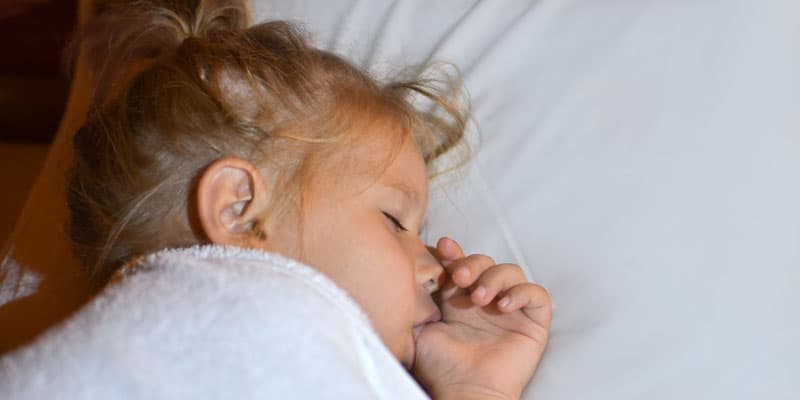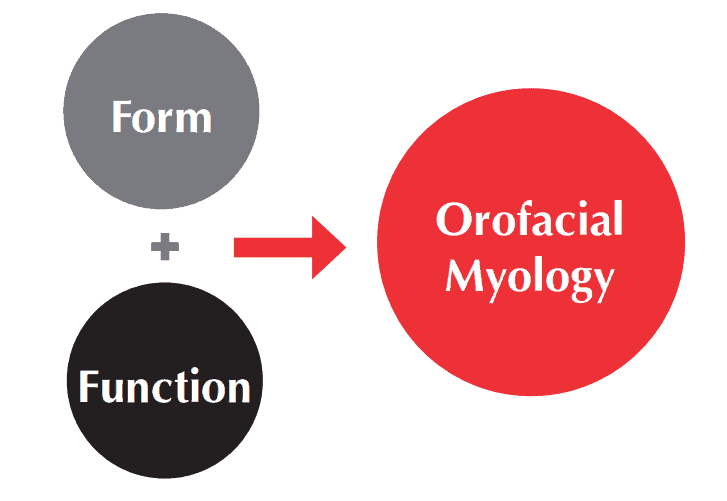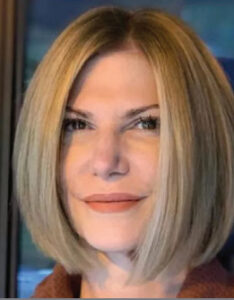Robyn Merkel-Walsh discusses the importance of recognizing four domains of orofacial myofunctional therapy — airway, feeding, structure, and speech.
 by Robyn Merkel-Walsh, MA, CCC-SLP, COM®
by Robyn Merkel-Walsh, MA, CCC-SLP, COM®
Introduction:
Orofacial Myofunctional Disorders (OMDs) encompass the four “MYO Domains” of airway, feeding, structure and speech. OMDs occur across the lifespan, are the nexus of function and structure and consider the interaction of how atypical movement patterns result in structural changes and how structural anomalies impact functional skills. Historically, only two national organizations list orofacial myofunctional therapy (OMT) in the scopes of practice of professionals. Speech Language Pathologists (SLPs) have OMDs in scope via the American Speech-Language Hearing Association (ASHA) and in state licensure. Registered Dental Hygienists (RDHs) have two policies on OMDs, #9-92 and PR 11-20 Resolution. Pediatric Orofacial Myofunctional Therapy (OMT) incorporates four specific domains:
- Airway is essential for sleep, attention, and well being
- Feeding is essential to grow and thrive
- Orofacial symmetry and harmony of the orofacial
complex is desirable - Articulate speech is necessary for communication
and success
Often the signs and symptoms of OMDs are based on the lens of the professional looking at the child. The orthodontist is concerned about structure, the speech pathologist is focused on oral placements for speech sounds, and the physical therapist is concerned with the jaw, neck pain and activities of daily living. Therefore, an OMD team is critical for the patient, because if there are only puzzle pieces that never make the whole picture, the whole child will not be complete and the OMD will persist.
Dentists should screen for OMDs and recognize when to refer.
Orofacial Myofunctional Therapy:
Historically, OMT was limited to patients 8-9 years and above (Hanson, 1978) but as the years have passed and the understanding of early intervention has grown, OMDs are now identified as early as infancy but the methodologies vary. OMDs fall under the oral motor umbrella (Merkel-Walsh, 2020) which includes other diseases and disorders that impact feeding, speech and structure in newborns, infants, and toddlers such as breastfeeding challenges and congenital hypotonia (Merkel-Walsh & Gatto, 2021).
There are three important principles to consider when a child has an OMD: 1) OMDs are treated by multi-modalities dependent on age and cognitive status of patient; 2) oral dysfunction requires oral motor intervention as the primary treatment modality with supportive interventions for the whole body and 3) while we can identify OMDS across the lifespan, scope of practice and evidence-based practices will determine who treats the child and by what modality (Merkel-Walsh & Gatto, 2021).
D’Onofrio (2019) pointed out that most infants are born with symmetrical faces and their acquired craniofacial dysmorphology are the results of chronic oral dysfunction. At any age, the lingual resting posture impacts the growth and shape of the palate, impacts speech intelligibility and is often related to prolonged sucking habits and malocclusion. Therefore, it is critical that all pediatric dental professionals make oral resting posture and airway/sleep screenings a part of their examination process (Zimmerman, 1985; Mat Zin, Rasib, Suhaimi & Mariatti ,2021; Góis, Ribeiro-Júnior, Vale, Paiva, Serra-Negra, Ramos-Jorge & Pordeus, 2008).
While newborns, infants, toddlers and those with neurodiversity may be too young, or not able to engage in volitional exercises typical of OMT, pre-feeding, oral motor and feeding therapies would be appropriate to start early intervention (Merkel-Walsh, 2020). Oral sensory-motor tools such as the Sensi® are used in therapy to stimulate movements to help prevent manifestations of OMDs.
Children over 4 with typical motor planning and average cognition are more readily able to self-monitor and engage in traditional OMT. These sessions often focus on oral resting posture, practicing nasal breathing, chewing, collecting a bolus, swallowing a bolus, reducing noxious habits and correcting atypical oral placements for speech.

The Four MYO Domains:
Airway: When children are congested, many well-meaning pediatricians conclude it is a “normal” part of childhood. Typically, when parents report sleep disturbances, OMDs often go undetected. Common symptoms such as snoring are viewed as normal, but common does not equate to normal (Baxter, 2022).
Children born with craniofacial anomalies are at an even greater risk of these complications. Signs and symptoms such as bedwetting, snoring, poor sleep habits, ADHD symptoms and open-mouthed posture may be missed and/or the connection between the airway and other symptoms are not fully understood in mainstreamed medicine. (Sano, Sano, Oka, Yoshino, & Kato,2013; Zhao, Zheng, Huang, Li, Liu & Hu, 2021; Mancini, Rudaizky, Pearcy, Marriner, Pestell, Gomez, Bucks, & Chen, 2019).
Etiology of airway dysfunction may include but is not limited to:
- Adenoidal hypertrophy
- Allergies
- Anaerobic infections
- Chronic rhinitis
- Nasal polyps
- Otitis media
- Sleep apnea
- Sinusitis
- Tonsillar hypertrophy
- Turbinate issues
- Upper airway resistance syndrome
Children with these challenges will need support from otolaryngologists, sleep specialists, allergists, and other physicians to assess and treat the underlying causes of the OMD. Then at four and up, SLPs and RDHs assist patients with diaphragmatic breathing, respiratory control, posture and alignment, nasal breathing, healthy nasal hygiene habits and oral resting posture to optimize growth and symmetry of the orofacial complex (Gatto, 2016).
Feeding: The process of feeding is one which encompasses a primary function of life and requires a baseline of structural harmony, muscular strength and stability and specific sequences of motor planning. The ability to take in a bolus, prepare it, transport it, and swallow it requires intricate movement of the nerves and muscles of the mouth and pharynx. Remediation of feeding disorders and dysphagia require specific licensure and postgraduate trainings most often complete by SLPs, but also studied by OTs and some PTs who work in very specific settings.
The oral phase of feeding may be impacted by an OMD and therefore those trained in orofacial myology often work on mastication, bolus preparation and the oral transport stage as a part of OMT. ASHA (n.d.) specifically lists modifying and handling of a bolus as a specific goal of OMT. It is important to note that while feeding problems overlap with OMT but are not synonymous. Feeding challenges can start immediately at birth and while this may be caused by an OMD such as ankyloglossia, it may also be due to respiratory issues, intubation, gastroenterology disease, prematurity and /or cardiac problems. In addition, any disruption to the sensory-motor system may result in food aversion, refusal, gagging and vomiting that may mistakenly be diagnosed as behaviors. In these cases, OMT would not be the appropriate plan of care and a feeding specialist; usually an SLP or an OT would need to be brought in for consultation (Overland & Merkel-Walsh, 2013).
Typically, in older children with OMDs, a “tongue-thrust” is noted, but this is usually a symptom of tethered oral tissue or airway concerns. In these cases, therapy generally consists of treating the underlying cause of the issue in addition to retraining the neuromuscular patterns of the tongue for swallowing with tongue retraction with tip elevation and lingual palatal suctioning
Structure: The hard tissue, soft tissue, muscles, and cranial nerves are equally important when studying orofacial myology. Benkert (2012), discussed the influence of environmental and function based on the work of Dr. Moss, knows as “Functional Matrix Theory” in which this theory was initially described. The longstanding debate of whether function impacts form or vice versa includes the functional and environmental influences impact the growth and development of the facial arches.
While SLPs are warned by ASHA that they cannot diagnose malocclusion or “move teeth”, studies have shown that OMT improves dental occlusion, decreasing open bite and overbite (Benkert, 1997, Van Dyck, Dekeyser, Vantricht, Manders, Goeleven, Fieuws & Willems, 2016). This is where the focus of OMT may sometimes vary between professions where orthodontists and dental professionals value OMT for the impact on dental alignment and prevention of orthodontic relapse while SLPs are more concerned with the improvement of speech clarity or swallowing. Both fields should recognize this form and function connection for the overall benefit for the pediatric patient.
Speech: The first three domains all have an impact on the articulatory placements for speech. SLPs specifically work on retraining the oral musculature through strength and resistance exercises, retraining oral placements and once the placements are corrected, drilling the sounds in words, phrases, sentences, and connected speech for improved clarity. They may use placement tools such as Bite Blocks or a Sensi (TalkTools®) to assist with correct oral placements. They may also work on vocal quality and pitch, oral versus nasal resonance and phonatory control all of which can be impacted by maladaptive muscle-based patterns (Ferreira, Mangilli, Sassi, Fortunato-Tavares, Limongi, Andrade CR, 2011; Zaghi, Valcu-Pinkerton, Jabara et al., 2019).
Referrals: As mentioned, the age of the patient and cognitive status impacts what modalities, techniques, exercises, and tools are used in therapy. In addition, the proper referral should always be made to licensed professionals who have specialized training in their area of expertise. National organizations make guidelines but ultimately state licensure is what dictates which professional is responsible for treatment in their state.
Babies should have their first dental examination by 12 months according to the American Academy of Pediatric Dentistry (2016). They should also be screened for OMDs such as breastfeeding challenges, weight gain, differential dental eruption, digestive issues, hypotonia, genetic syndromes and tongue-tie. Referrals for children under four years of age, who have special needs, or with suspected OMDs, should be made to a licensed SLP or OMT who specializes in pediatric feeding. The referral depends on comorbidity of speech and language disorders, availability of local providers, and family finances.
In ages four and above, referrals are best directed to a licensed SLP or RDH with specialized training in orofacial myology, in particular, one who is a Board-Certified Orofacial Myologist (COM®).
Examples of signs and symptoms that warrant an OMD evaluation in pediatric patients four and above includes but is not limited to (Billings, D’Onofrio, Gatto, Merkel-Walsh & Archambault, 2018):
- Anterior dental issues such as overjet and open bite
- Articulation issues
- Crowded teeth
- Dental Malocclusion (overbite, open bite, overjet, etc.)
- Deviated septum
- Diastemas of teeth
- Enlarged tonsils and/or adenoids
- High and /or narrow plate
- Low, forward, or interdental lingual resting posture
- Mouth breathing
- Open mouthed posture
- Orofacial hypotonia
- Orthodontic relapse
- Signs of nighttime arousals such as bedwetting, bruxism or restless sleep
- Snoring
- Tethered oral tissue
- Thumb sucking or any noxious oral habits
- Tongue scalloping or injuries
- Tongue thrusting
- Torus Palatinus
- Upper Airway Resistance Syndrome (UARS)
- Xerostomia (dry mouth)
Conclusions:
OMT is an evidence-based approach to improve airway health, feeding, optimal orofacial growth and development and speech clarity for children and adults when performed by licensed professionals who have professional scope of practice and specialized training. OMT can support the goals of the dentist, oral surgeon and /or orthodontist regarding dental health, alignment, and optimal surgical outcomes. Dental professionals should have awareness of Orofacial Myofunctional Disorders and be able to screen for the signs and symptoms of OMDs and refer accordingly to optimize the overall health of their patients. Information on orofacial myology, airway health, finding a trained OMT provider, and more can be found through the International Associational of Orofacial Myology, (www.iaom.com), The Academy of Applied Medicine and Physiology (www.aapmd.org) and The Oral Motor Institute (www.oralmotorinstitute.org) all of which are non-profit organizations.
Kristie Gatto discusses her view of orofacial myofunctional therapy and the role of the orofacial myoloist. Read her article here: https://dentalsleeppractice.com/myofunctional-therapy/
- American Academy of Pediatric Dentistry (2016). Guideline on perinatal and infant oral health care. Pediatr Dent, 38(special issue):150-154.
- American Speech-Language-Hearing Association. (n.d.). Orofacial Myofunctional Disorders. (Practice Portal). Retrieved February, 13, 2022 from www.asha.org/Practice-Portal/Clinical-Topics/Orofacial-Myofunctional-
Disorders/. - Baxter, R. Tongue Tie Lite (2022). Presentation from The Alabama Tongue-Tie Center. Recorded and viewed February 27, 2022.
- Benkert, K. K. (2012) The function junction. The Journal of American Orthodontic Society, May/June, 28-40.
- Benkert K. K. (1997). The effectiveness of orofacial myofunctional therapy in improving dental occlusion. The International journal of orofacial myology: official publication of the International Association of Orofacial Myology, 23, 35–46.
- Billings, M., D’Onofrio, L., Gatto, K. Merkel-Walsh, R. & Archambault, N. (2018). Orofacial myofunctional disorders. Retrieved From: http://iaom.com/wp-content/uploads/2018/10/OMD-Overview-IAOM.pdf
- D’Onofrio, L. (2019). Oral dysfunction as a cause of malocclusion. Orthod Craniof Res.22, (Suppl. 1): 43-48
- Ferreira TS, Mangilli LD, Sassi FC, Fortunato-Tavares T, Limongi SC, Andrade CR (2011). Speech and myofunctional exercise physiology: a critical review of the literature. Jornal da Sociedade Brasileira de Fonoaudiologia, Sep;23(3):288-96.
- Gatto, K. K. (2016). Understanding the orofacial complex: The evolution of dysfunction. Outskirts Press.
- Góis, E. G., Ribeiro-Júnior, H. C., Vale, M. P., Paiva, S. M., Serra-Negra, J. M., Ramos-Jorge, M. L., & Pordeus, I. A. (2008). Influence of nonnutritive sucking habits, breathing pattern and adenoid size on the development of malocclusion. The Angle orthodontist, 78(4), 647–654. https://doi.org/10.2319/0003-3219(2008)078[0647:IONSHB]2.0.CO;2
- Mancini, V. O., Rudaizky, D., Pearcy, B., Marriner, A., Pestell, C. F., Gomez, R., Bucks, R. S., & Chen, W. (2019). Factor structure of the Sleep Disturbance Scale for Children (SDSC) in those with Attention Deficit and Hyperactivity Disorder (ADHD). Sleep medicine: X, 1, 100006. https://doi.org/10.1016/j.sleepx.2019.100006
- Mat Zin, S., Md Rasib, S. Z., Suhaimi, F. M., & Mariatti, M. (2021). The technology of tongue and hard palate contact detection: a review. Biomedical engineering online, 20(1), 17. https://doi.org/10.1186/s12938-021-00854-y
- Merkel-Walsh, R. & Gatto, K. (2021). The Team approach in treating oral sensory-motor dysfunction in newborns, infants, and babies with a diagnosis of tethered oral tissue. Journal of the American Laser Study Club.
- Merkel-Walsh, R. (2020). Orofacial myofunctional therapy with children ages 0-4 and individuals with special needs. International Journal of Orofacial Myology and Myofunctional Therapy, 46(1), 22-36.DOI: https://doi.org/10.52010/ijom.2020.46.1.3
- Overland, L. & Merkel-Walsh, R. (2013). A sensory-motor approach to feeding. Charleston, SC: TalkTools.
- Sano, M., Sano, S., Oka, N., Yoshino, K., & Kato, T. (2013). Increased oxygen load in the prefrontal cortex from mouth breathing: a vector-based near-infrared spectroscopy study. Neuroreport, 24(17), 935–940. https://doi.org/10.1097/WNR.0000000000000008
- Van Dyck, C., Dekeyser, A., Vantricht, E., Manders, E., Goeleven, A., Fieuws, S., & Willems, G. (2016). The effect of orofacial myofunctional treatment in children with anterior open bite and tongue dysfunction: a pilot study. European Journal of Orthodontics, 38(3), 227–234. https://doi.org/10.1093/ejo/cjv044
- Zaghi, S., Valcu-Pinkerton, S., Jabara, M., Norouz-Knutsen, L., Govardhan, C., Moeller, J., Sinkus, V., Thorsen, R.S., Downing, V., Camacho, M., Yoon, A., Hang, W.M., Hockel, B., Guilleminault, C. and Liu, S.Y.-C. (2019), Lingual frenuloplasty with myofunctional therapy: Exploring safety and efficacy in 348 cases. Laryngoscope Investigative Otolaryngology, 4: 489-496. https://doi.org/10.1002/lio2.297
- Zimmerman E. F. (1985). Role of neurotransmitters in palate development and teratologic implications. Progress in clinical and biological research, 171, 283–294.
- Zhao, Z., Zheng, L., Huang, X., Li, C., Liu, J., & Hu, Y. (2021). Effects of mouth breathing on facial skeletal development in children: a systematic review and meta-analysis. BMC oral health, 21(1), 108. https://doi.org/10.1186/s12903-021-01458-7
 Robyn Merkel-Walsh is a NJ and NY licensed speech-language pathologist and Board-Certified Orofacial Myologist with more than 27 years of experience. She works for the Ridgefield Board of Education, is the owner of Diamond Myo, is a speaker, author, and consultant for TalkTools®, Board Chair of the Oral Motor Institute, and an Ambassador of The Breathe Institute. She has authored and co-authored texts, therapy programs, and peer-reviewed journal articles. She can be reached at robynslp95@aol.com.
Robyn Merkel-Walsh is a NJ and NY licensed speech-language pathologist and Board-Certified Orofacial Myologist with more than 27 years of experience. She works for the Ridgefield Board of Education, is the owner of Diamond Myo, is a speaker, author, and consultant for TalkTools®, Board Chair of the Oral Motor Institute, and an Ambassador of The Breathe Institute. She has authored and co-authored texts, therapy programs, and peer-reviewed journal articles. She can be reached at robynslp95@aol.com.